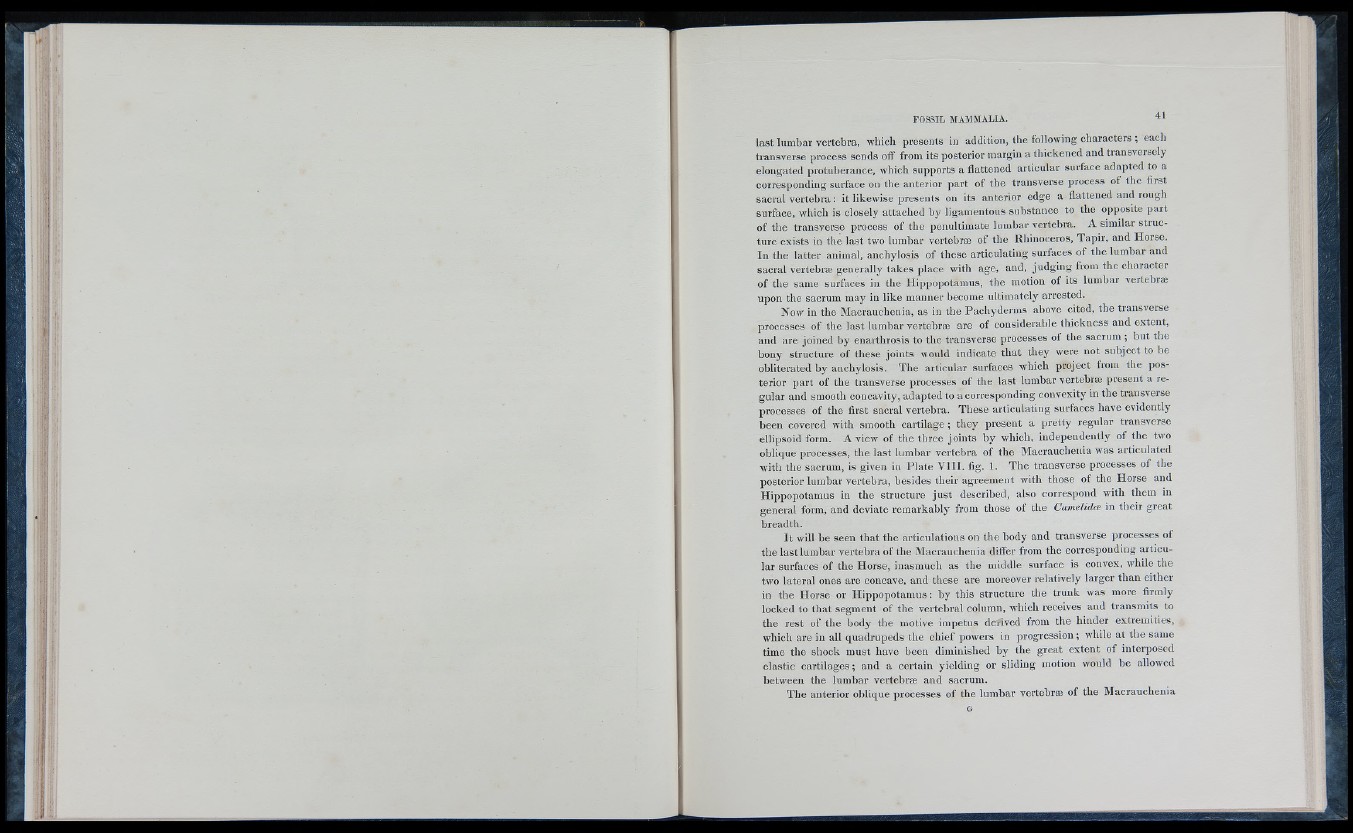
:'A
'.Î
la st lumbar vertebra, which presents in addition, the following characters ; each
transverse process sends off from its posterior margin a thickened and transversely
elongated protuberance, which supports a flattened articular surface adapted to a
corresponding surface on the anterior part o f the transverse process o f the first
sacral vertebra : it likewise presents on its anterior edge a flattened and rough
surface, which is closely attached b y ligamentous substance to the opposite part
o f the transverse process o f the penultimate lumbar vertebra. A similar structure
ex ists in the last two lumbar vertebræ o f the Rhinoceros, Tapir, and Horse.
In the latter animal, anchylosis o f these articulating surfaces o f the lumbar and
sacral vertebræ generally takes place with age, and, judging from the character
o f the same surfaces in the Hippopotamus, the motion o f its lumbar vertebræ
upon the sacrum may in lik e manner become ultimately arrested.
Now in the Macrauchenia, as in the Pachyderms above cited, the transverse
processes o f the la st lumbar vertebræ are o f considerable thickness and extent,
and are joined by enaithrosis to the transverse processes o f the sacrum ; hut the
bony structure o f these joints would indicate that they were not subject to be
obliterated by anchylosis. The articular surfaces which project from the p osterior
part o f the transverse processes o f the la st lumbar vertebræ present a regular
and smooth concavity, adapted to a corresponding convexity in the transverse
processes o f the first sacral vertebra. These articulating surfaces have evidently
been covered with smooth cartilage ; they present a pretty regular transverse
ellipsoid form. A view o f the three joints b y which, independently o f the two
oblique processes, the last lumbar vertebra o f the Macrauclietiia was articulated
with the sacrum, is given in P la te V II I . fig. 1. T he transverse processes o f the
posterior lumbar vertebra, besides their agreement with those oi the Horse and
Hippopotamus in the structure ju s t described, also coiTespoiid with them in
general form, and deviate remarkably from those o f the Camelidæ in their great
breadth.
I t will be seen that the articulations on the body and transverse processes o f
the la st lumbar vertebra o f the Macrauchenia differ from the corresponding articular
surfaces o f the Horse, inasmuch as the middle surface is convex, while the
two lateral ones are concave, and these are moreover relatively larger than either
in the Horse or Hippopotamus : by this structure the trunk was more firmly
locked to that segment o f the vertebral column, which receives and transmits to
the rest o f the body the motive impetus derived from the hinder extremities,
which are in all quadrupeds the ch ie f powers in progression ; while at the same
time the shock must have been diminished by the great ex tent o f interposed
ela stic ca r tila g es; and a certain yie lding or sliding motion would be allowed
between the lumbar vertebræ and sacrum.
The anterior oblique processes o f the lumbar vertebræ o f the Macrauchenia